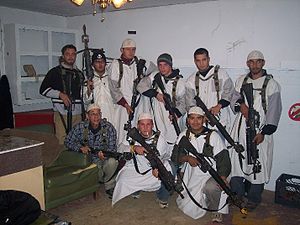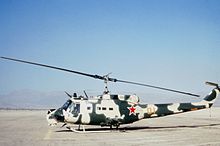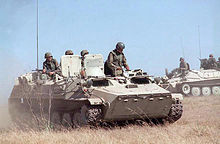- Opposing force
-
- The term opposing force is occasionally used to refer to a genuine military foe. This article is concerned only with its use in simulated conflict.
An opposing force (abbreviated OPFOR, used in the United States and Australia) or enemy force (used in Canada) is a military unit tasked with representing an enemy, usually for training purposes in war game scenarios. The related concept of aggressor squadron is used by some air forces.
At a basic level, a unit might serve as an opposing force for a single scenario, differing from its 'opponents' only in the objectives it is given. However, major armies commonly maintain specialized groups trained to accurately emulate real-life enemies, to provide a more realistic experience for their training opponents. (To avoid the diplomatic ramifications of naming a real nation as a likely enemy, training scenarios often use fictionalized versions with different names but similar military characteristics to the expected real-world foes.)
Opposing forces can also coincide with red teaming activities. Once the Analytic Red Team develops adversary tactics, techniques, and procedures (TTPs) it will be the opposing force that makes use of those TTPs in wargames and exercises.
Some dedicated opposing forces may fight using the likely enemy's doctrine, weapons, and equipment. They may wear uniforms which resemble the likely enemy's, or one dissimilar to "friendly forces". Their vehicles may either be those operated by the likely enemy's, or may be modified to look like those. All these measures help to enhance training realism and provide useful lessons on how to fight this particular enemy.
Blank ammunition, smoke grenades, and artillery simulators are often used by both sides in the exercise to provide the fog of war caused by the noise and smoke of battle.
In addition, a simulation system such as the Multiple Integrated Laser Engagement System (MILES) may be used. This system is attached to various weapons, and are zeroed to the sights of the weapon. When a blank round is fired, the system sends out a laser beam, which score "kills" or "injuries" on any soldier or vehicle in what would be the path of the weapon's projectile. These laser beams are detected by receivers on harnesses worn by the soldiers, or on the vehicle itself.
Alternatively, paintball weapons which look like real weapons, or simulation rounds such as plastic bullets may be used. Usually, controllers follow the training troops to help score additional kills, such as when a simulated grenade is thrown. They may do so with the MILES system using a controller gun. All these measures help to emphasize the importance of aimed fire, and taking cover. These concepts, while obvious, are often neglected in ordinary one-sided training exercises because the soldier does not suffer the consequences.
Units
One of the best-known examples of specialist operations is the United States' OPFOR. During the Cold War, opposing force units employed Soviet military doctrine and simulated Soviet equipment; since the fall of the USSR, US opposing force units have become more flexible to represent a wider range of opponents. More recently training has focused on Iraq and Afghanistan.
There are three Major Training Centers that utilize home-based OPFOR units for the US Army:
- The National Training Center or NTC at Fort Irwin, California -- home unit is the 11th Armored Cavalry Regiment (the Blackhorse)
- The Joint Readiness Training Center or JRTC at Fort Polk, Louisiana -- home unit is the 1st Battalion, 509th Parachute Infantry Regiment (the Geronimos')'
- The Joint Multinational Readiness Center or JMRC (formerly known as the Combat Maneuver Training Center or CMTC) at Hohenfels, Germany[1] -- home unit is the 1st Battalion, 4th Infantry Regiment (Separate) (the Warriors)
The units at NTC and JMRC were used to replicate a Soviet Motorized Rifle regiment or division. At NTC, M551 Sheridans were used to replicate Soviet T-80 tanks until 2003. Visually Modified (VISMOD) HMMWVs are used to replicate BRDM-2s, VISMOD M113A2s (known as the OPFOR Surrogate Vehicle [OSV]) are used to replicate BMP-2 Infantry Fighting Vehicles (IFV), while VISMOD M1 Abrams Tanks (known as the Krasnovian Variant Tank [KVT]) and M113A2s (known as the OPFOR Surrogate Vehicle, Tank [OSV-T]) are also used to replicate the T-80. At JMRC, M113A2s are used to replicate Soviet BMP-2s and M60A3 tanks are used to replicate Soviet T-80s.
During the mid-1990s, JMRC was used to train peacekeeping forces for the former Yugoslavia under low-intensity conflict missions. Currently, the OpFor mission has since been modified for counter-insurgency training for Operation Iraqi Freedom and Operation Enduring Freedom.
Starting in early 2004, NTC began focusing on training units selected to deploy to Iraq or Afghanistan in urban operations (UO). Towns of ever increasing size and complexity have been constructed throughout the training area to provide battlefield realism and housing for the hundreds of role-playing personnel, many of whom speak Arabic or Kurdish natively, and replicate civilians On the battlefield while wearing Afghan or Iraqi clothing. Cultural awareness and liaison operations with local leaders are emphasized at all times and at all levels.
Various US military installations and/or major units have their own local versions of opposing force used for training exercises. The joint Australian/US military exercise "Crocodile '03" featured an Australian-led opposing force in which soldiers from a range of Australian units worked together with a US Marine Corps contingent.[2]
The British Army rotates units through British Army Training Unit Suffield as OPFOR.
References
- ^ Army.mil
- ^ John Wellfare. "Exercise Crocodile '03: You win some, you lose some". Army: The Soldiers' Newspaper. http://www.defence.gov.au/news/armynews/editions/1084/features/feature01a.htm.
Further reading
- Validating the "Enemy" (discusses the USA's OPFOR units, and post-Cold War changes to OPFOR.)
Categories:
Wikimedia Foundation. 2010.



